Abstract
1 Pretreatment of rats with p-chlorophenylalanine (PCPA; 2 X 200 mg/kg) decreased the concentration of 5-hydroxytryptamine (5-HT) in the brain. It also decreased the locomotor activity produced by tranylcypromine plus L-DOPA administration 24 h after the second dose of PCPA. 2 Pretreatment with p-chloroamphetamine, which produced a similar decrease in brain 5-HT concentrations did not decrease the locomotor response to tranylcypromine and L-DOPA. 3 PCPA pretreatment decreased the rise in the concentration of DOPA and dopamine in the brain following tranylcypromine and L-DOPA, suggesting its effect on the dopamine-induced locomotor activity was the result of this drug diminishing dopamine formation in the brain, probably by inhibiting L-DOPA uptake. 4 The locomotor activity produced by tranylcypromine and L-DOPA was not decreased by pretreatment 6 h earlier with disulfiram (400 mg/kg). This argues against the locomotor activity being due to noradrenergic stimulation. 5 PCPA pretreatment did not alter amphetamine-induced stereotypy or the circling behaviour in unilateral nigro-striatal lesioned rats.
Full text
PDF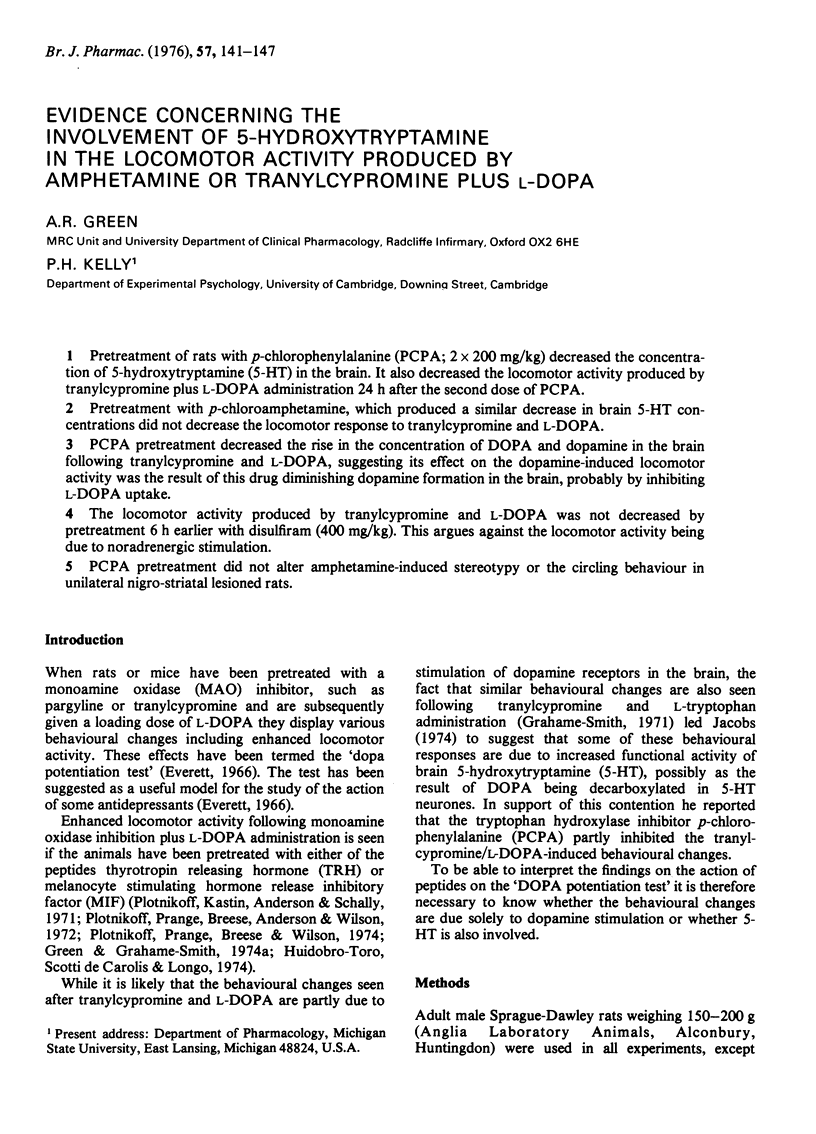
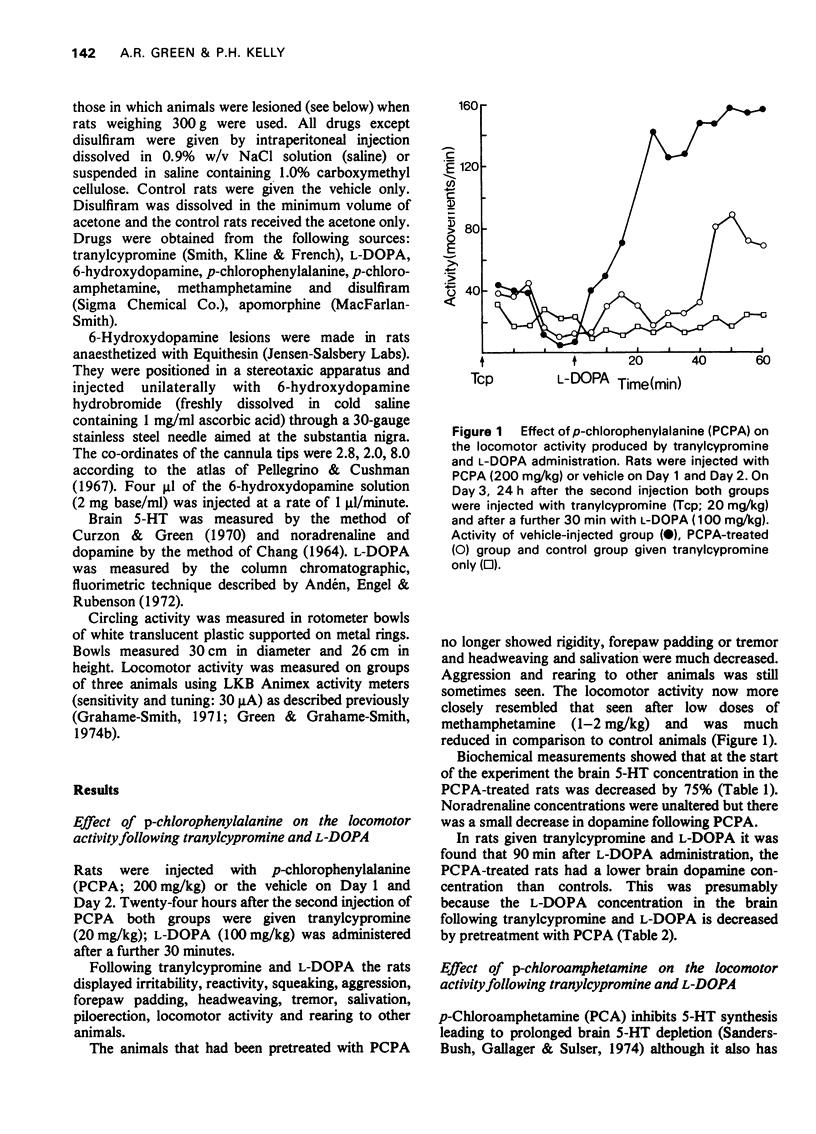
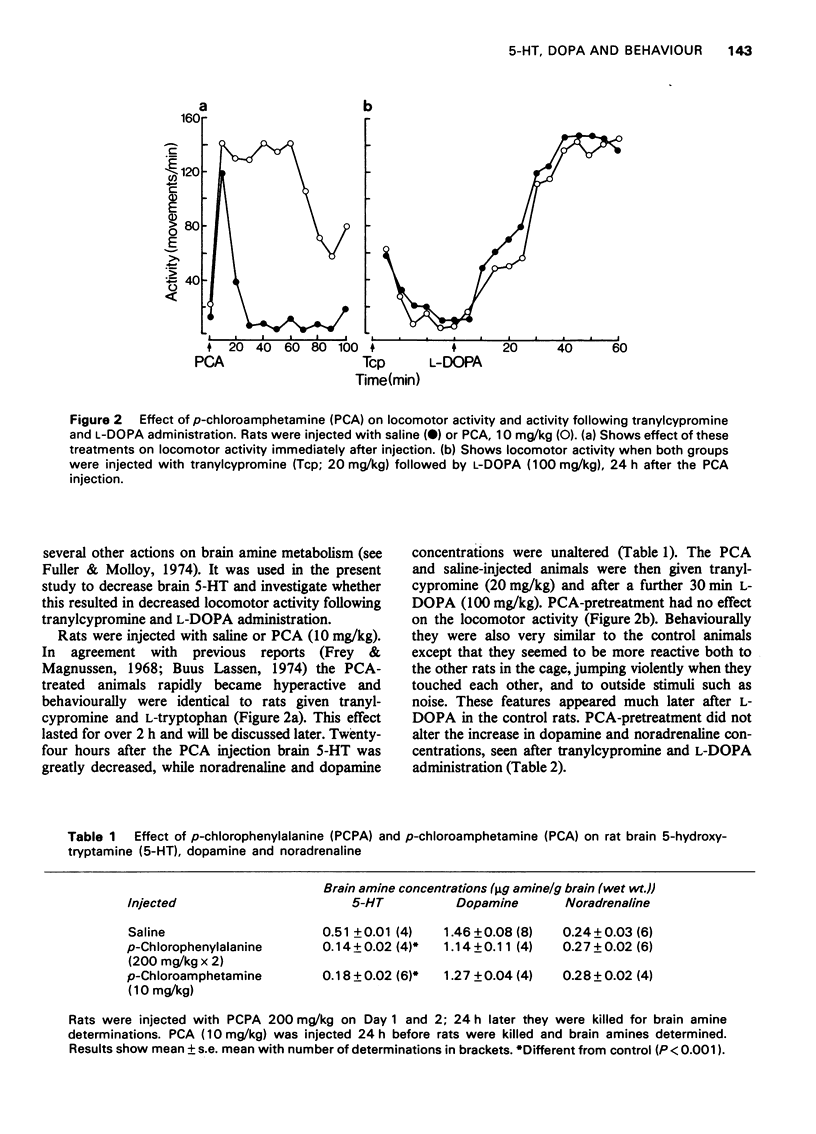
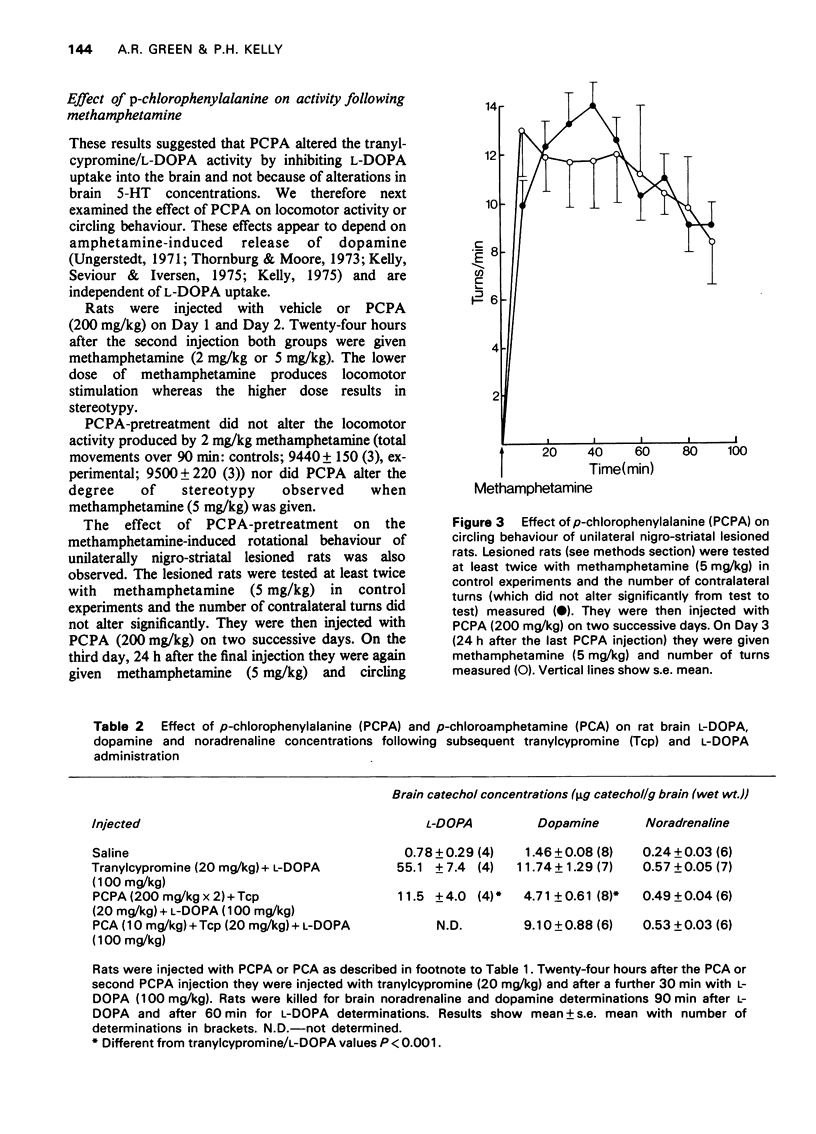
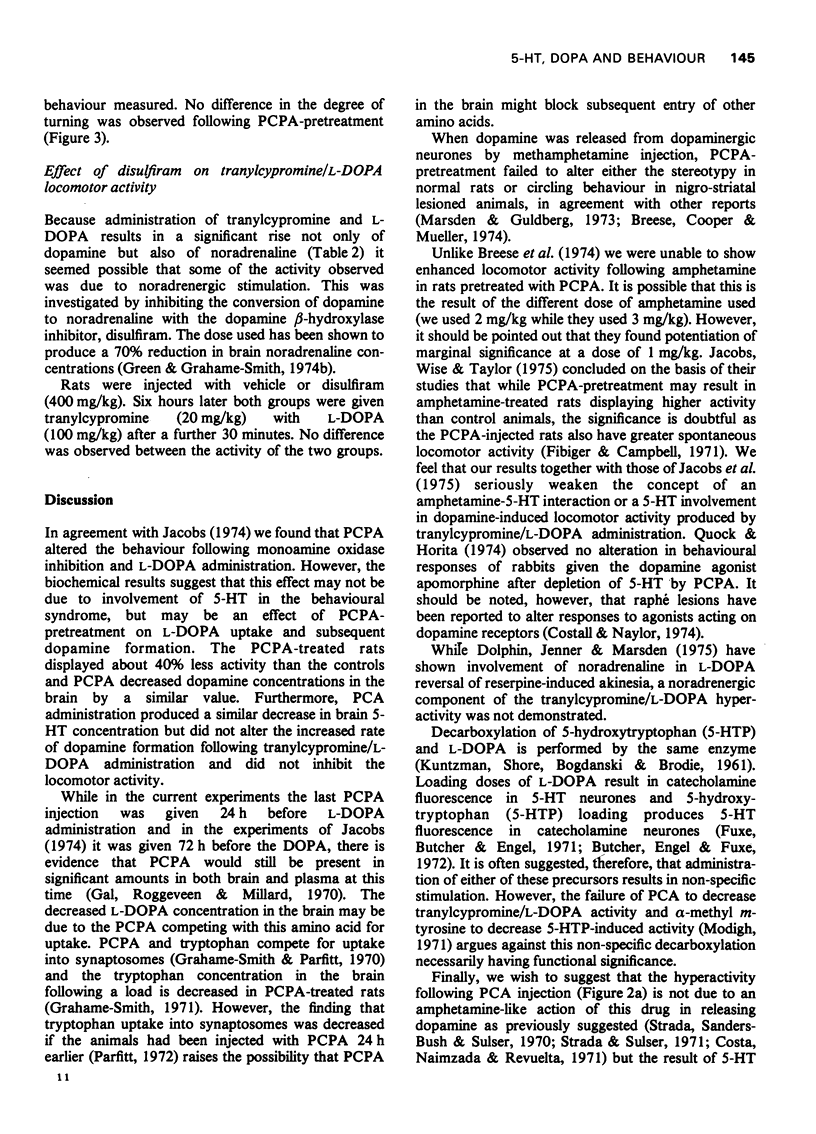
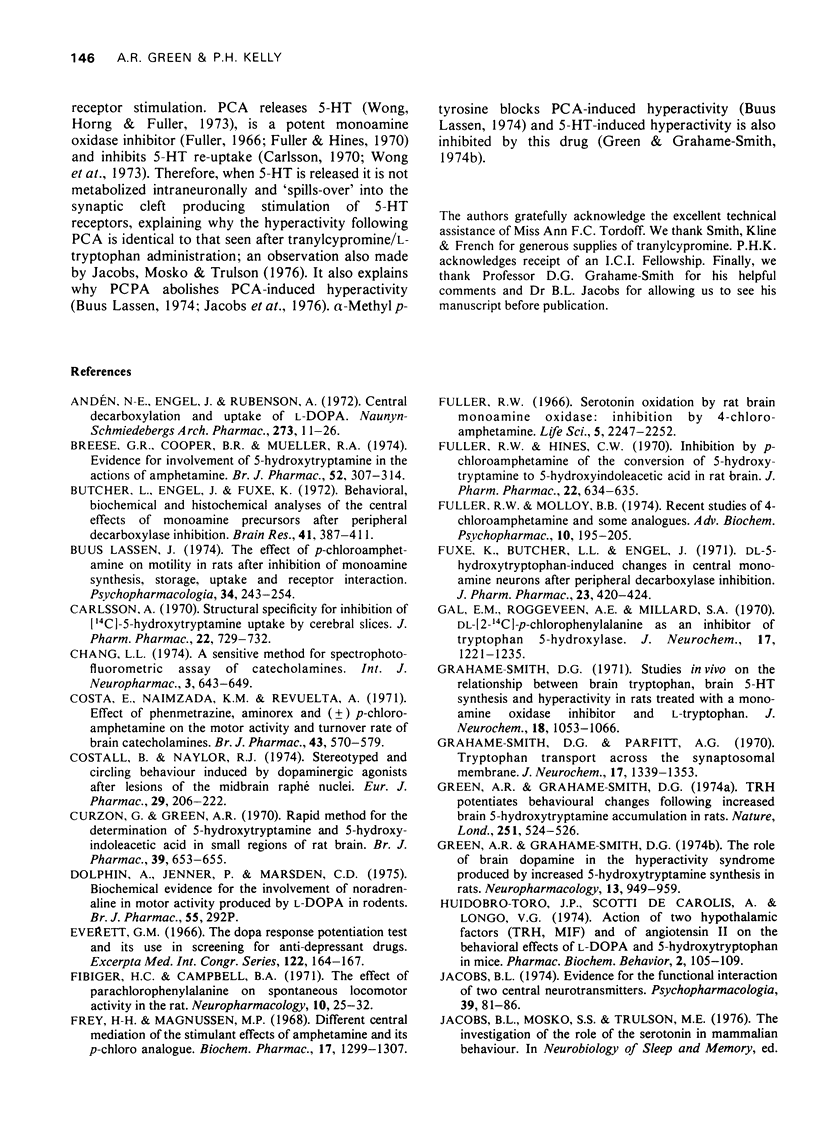
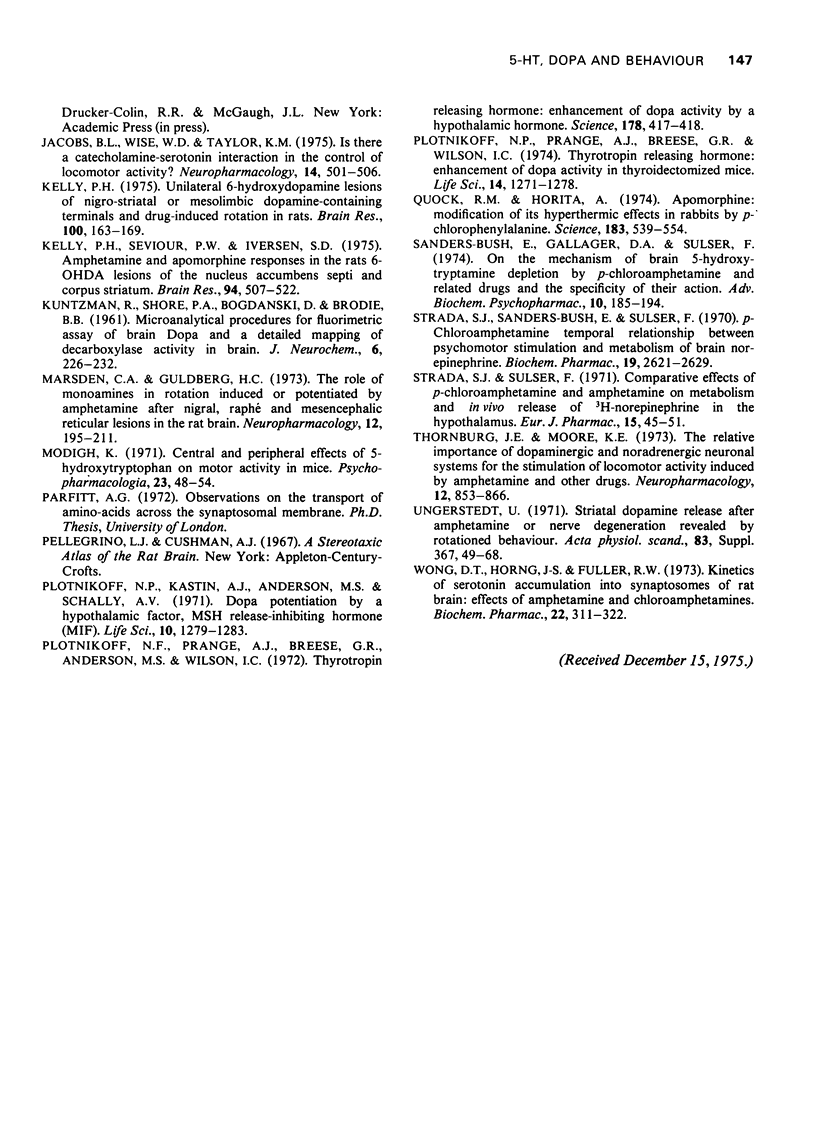
Selected References
These references are in PubMed. This may not be the complete list of references from this article.
- Andén N. E., Engel J., Rubenson A. Central decarboxylation and uptake of L-DOPA. Naunyn Schmiedebergs Arch Pharmacol. 1972;273(1):11–26. doi: 10.1007/BF00508077. [DOI] [PubMed] [Google Scholar]
- Breese G. R., Cooper B. R., Mueller R. A. Evidence for involvement of 5-hydroxytryptamine in the actions of amphetamine. Br J Pharmacol. 1974 Oct;52(2):307–314. doi: 10.1111/j.1476-5381.1974.tb09714.x. [DOI] [PMC free article] [PubMed] [Google Scholar]
- Butcher L. L., Engel J., Fuxe K. Behavioral, biochemical, and histochemical analyses of the central effects of monoamine precursors after peripheral decarboxylase inhibition. Brain Res. 1972 Jun 22;41(2):387–411. doi: 10.1016/0006-8993(72)90510-0. [DOI] [PubMed] [Google Scholar]
- CHANG C. C. A SENSITIVE METHOD FOR SPECTROPHOTOFLUOROMETRIC ASSAY OF CATECHOLAMINES. Int J Neuropharmacol. 1964 Dec;3:643–649. doi: 10.1016/0028-3908(64)90089-9. [DOI] [PubMed] [Google Scholar]
- Carlsson A. Structural specificity for inhibition of [14C]-5-hydroxytryptamine uptake by cerebral slices. J Pharm Pharmacol. 1970 Oct;22(10):729–732. doi: 10.1111/j.2042-7158.1970.tb08419.x. [DOI] [PubMed] [Google Scholar]
- Costa E., Naimzada K. M., Revuelta A. Effect of phenmetrazine, aminorex and ( ) p-chloramphetamine on the motor activity and turnover rate of brain catecholamines. Br J Pharmacol. 1971 Nov;43(3):570–579. doi: 10.1111/j.1476-5381.1971.tb07187.x. [DOI] [PMC free article] [PubMed] [Google Scholar]
- Costall B., Naylor R. J. Stereotyped and circling behaviour induced by dopaminergic agonists after lesions of the midbrain raphe nuclei. Eur J Pharmacol. 1974 Dec;29(2):206–222. doi: 10.1016/0014-2999(74)90019-3. [DOI] [PubMed] [Google Scholar]
- Curzon G., Green A. R. Rapid method for the determination of 5-hydroxytryptamine and 5-hydroxyindoleacetic acid in small regions of rat brain. Br J Pharmacol. 1970 Jul;39(3):653–655. doi: 10.1111/j.1476-5381.1970.tb10373.x. [DOI] [PMC free article] [PubMed] [Google Scholar]
- Dolphin A., Jenner P., Marsden C. D. Proceedings: Biochemical evidence for the involvement of noradrenaline in motor activity produced by L-DOPA in rodents. Br J Pharmacol. 1975 Oct;55(2):292P–292P. [PMC free article] [PubMed] [Google Scholar]
- Fibiger H. C., Campbell B. A. The effect of para-chlorophenylalanine on spontaneous locomotor activity in the rat. Neuropharmacology. 1971 Jan;10(1):25–32. doi: 10.1016/0028-3908(71)90005-0. [DOI] [PubMed] [Google Scholar]
- Frey H. H., Magnussen M. P. Different central mediation of the stimulant effects of amphetamine and its p-chloro analogue. Biochem Pharmacol. 1968 Jul;17(7):1299–1307. doi: 10.1016/0006-2952(68)90067-1. [DOI] [PubMed] [Google Scholar]
- Fuller R. W., Hines C. W. Inhibition by p-chloroamphetamine of the conversion of 5-hydroxytryptamine to 5-hydroxyindoleacetic acid in rat brain. J Pharm Pharmacol. 1970 Aug;22(8):634–635. doi: 10.1111/j.2042-7158.1970.tb10589.x. [DOI] [PubMed] [Google Scholar]
- Fuller R. W., Molloy B. B. Recent studies with 4-chloramphetamine and some analogues. Adv Biochem Psychopharmacol. 1974;10:195–205. [PubMed] [Google Scholar]
- Fuxe K., Butcher L. L., Engel J. DL-5-hydroxytryptophan-induced changes in central monoamine neurons after peripheral decarboxylase inhibition. J Pharm Pharmacol. 1971 Jun;23(6):420–424. doi: 10.1111/j.2042-7158.1971.tb08673.x. [DOI] [PubMed] [Google Scholar]
- Grahame-Smith D. G., Parfitt A. G. Tryptophan transport across the synaptosomal membrane. J Neurochem. 1970 Sep;17(9):1339–1353. doi: 10.1111/j.1471-4159.1970.tb06869.x. [DOI] [PubMed] [Google Scholar]
- Grahame-Smith D. G. Studies in vivo on the relationship between brain tryptophan, brain 5-HT synthesis and hyperactivity in rats treated with a monoamine oxidase inhibitor and L-tryptophan. J Neurochem. 1971 Jun;18(6):1053–1066. doi: 10.1111/j.1471-4159.1971.tb12034.x. [DOI] [PubMed] [Google Scholar]
- Green A. R., Grahame-Smith D. G. TRH potentiates behavioural changes following increased brain 5-hydroxytryptamine accumulation in rats. Nature. 1974 Oct 11;251(5475):524–526. doi: 10.1038/251524a0. [DOI] [PubMed] [Google Scholar]
- Green A. R., Grahame-Smith D. G. The role of brain dopamine in the hyperactivity syndrome produced by increased 5-hydroxytryptamine synthesis in rats. Neuropharmacology. 1974 Nov;13(10-11):949–959. doi: 10.1016/0028-3908(74)90086-0. [DOI] [PubMed] [Google Scholar]
- Gál E. M., Roggeveen A. E., Millard S. A. DL-[2-14C]p-chlorophenylalanine as an inhibitor of tryptophan 5-hydroxylase. J Neurochem. 1970 Aug;17(8):1221–1235. doi: 10.1111/j.1471-4159.1970.tb03372.x. [DOI] [PubMed] [Google Scholar]
- Huidobro-Toro J. P., De Carolis A. S., Longo V. G. Action of two hypothalamic factors (TRH, MIF) and of angiotensin II on the behavioral effects of L-DOPA and 5-hydroxytryptophan in mice. Pharmacol Biochem Behav. 1974 Jan-Feb;2(1):105–109. doi: 10.1016/0091-3057(74)90141-5. [DOI] [PubMed] [Google Scholar]
- Jacobs B. L. Evidence for the functional interaction of two central neurotransmitters. Psychopharmacologia. 1974;39(1):81–86. doi: 10.1007/BF00421461. [DOI] [PubMed] [Google Scholar]
- KUNTZMAN R., SHORE P. A., BOGDANSKI D., BRODIE B. B. Microanalytical procedures for fluorometric assay of brain DOPA-5HTP decarboxylase, norepinephrine and serotonin, and a detailed mapping of decarboxylase activity in brain. J Neurochem. 1961 Feb;6:226–232. doi: 10.1111/j.1471-4159.1961.tb13469.x. [DOI] [PubMed] [Google Scholar]
- Kelly P. H., Seviour P. W., Iversen S. D. Amphetamine and apomorphine responses in the rat following 6-OHDA lesions of the nucleus accumbens septi and corpus striatum. Brain Res. 1975 Sep 5;94(3):507–522. doi: 10.1016/0006-8993(75)90233-4. [DOI] [PubMed] [Google Scholar]
- Kelly P. H. Unilateral 6-hydroxydopamine lesions of nigrostriatal or mesolimbic dopamine-containing terminals and the drug-induced rotation of rats. Brain Res. 1975 Dec 12;100(1):163–169. doi: 10.1016/0006-8993(75)90253-x. [DOI] [PubMed] [Google Scholar]
- Lassen J. B. The effect of p-chloroamphetamine on motility in rats after inhibition of monoamine synthesis, storage, uptake and receptor interaction. Psychopharmacologia. 1974 Jan 14;34(3):243–254. doi: 10.1007/BF00421965. [DOI] [PubMed] [Google Scholar]
- Marsden C. A., Guldberg H. C. The role of monoamines in rotation induced or potentiated by amphetamine after nigral, raphe and mesencephalic reticular lesions in the rat brain. Neuropharmacology. 1973 Mar;12(3):195–211. doi: 10.1016/0028-3908(73)90104-4. [DOI] [PubMed] [Google Scholar]
- Modigh K. Central and peripheral effects of 5-hydroxytryptophan on motor activity in mice. Psychopharmacologia. 1972;23(1):48–54. doi: 10.1007/BF00414413. [DOI] [PubMed] [Google Scholar]
- Plotnikoff N. P., Kastin A. J., Anderson M. S., Schally A. V. DOPA potentiation by a hypothalamic factor, MSH release-inhibiting hormone (MIF). Life Sci I. 1971 Nov 15;10(22):1279–1283. doi: 10.1016/0024-3205(71)90326-2. [DOI] [PubMed] [Google Scholar]
- Plotnikoff N. P., Prange A. J., Jr, Breese G. R., Anderson M. S., Wilson I. C. Thyrotropin releasing hormone: enhancement of dopa activity by a hypothalamic hormone. Science. 1972 Oct 27;178(4059):417–418. doi: 10.1126/science.178.4059.417. [DOI] [PubMed] [Google Scholar]
- Plotnikoff N. P., Prange A. J., Jr, Breese G. R., Wilson I. C. Thyrotropin releasing hormone: enhancement of DOPA activity in thyroidectomized rats. Life Sci. 1974 Apr 1;14(7):1271–1278. doi: 10.1016/0024-3205(74)90435-4. [DOI] [PubMed] [Google Scholar]
- Quock R. M., Horita A. Apomorphine: modification of its hyperthermic effect in rabbits by p-chlorophenylalanine. Science. 1974 Feb 8;183(4124):539–540. doi: 10.1126/science.183.4124.539. [DOI] [PubMed] [Google Scholar]
- Sanders-Bush E., Gallager D. A., Sulser F. On the mechanism of brain 5-hydroxytryptamine depletion by p-chloroamphetamine and related drugs and the specificity of their action. Adv Biochem Psychopharmacol. 1974;10:185–194. [PubMed] [Google Scholar]
- Strada S. J., Sanders-Bush E., Sulser F. p-Chloroamphetamine. Temporal relationship between psychomotor stimulation and metabolism of brain norepinephrine. Biochem Pharmacol. 1970 Sep;19(9):2621–2629. doi: 10.1016/0006-2952(70)90012-2. [DOI] [PubMed] [Google Scholar]
- Strada S. J., Sulser F. Comparative effects of P-chloroamphetamine and amphetamine on metabolism and in vivo release of 3 H-norepinephrine in the hypothalamus. Eur J Pharmacol. 1971 Jun;15(1):45–51. doi: 10.1016/0014-2999(71)90077-x. [DOI] [PubMed] [Google Scholar]
- Taylor K. M. Is there a catecholamine-serotonin interaction in the control of locomotor activity? Neuropharmacology. 1975 Jul;14(7):501–506. doi: 10.1016/0028-3908(75)90054-4. [DOI] [PubMed] [Google Scholar]
- Thornburg J. E., Moore K. E. The relative importance of dopaminergic and noradrenergic neuronal systems for the stimulation of locomotor activity induced by amphetamine and other drugs. Neuropharmacology. 1973 Sep;12(9):853–866. doi: 10.1016/0028-3908(73)90038-5. [DOI] [PubMed] [Google Scholar]
- Ungerstedt U. Striatal dopamine release after amphetamine or nerve degeneration revealed by rotational behaviour. Acta Physiol Scand Suppl. 1971;367:49–68. doi: 10.1111/j.1365-201x.1971.tb10999.x. [DOI] [PubMed] [Google Scholar]
- Wong D. T., Horng J. S., Fuller R. W. Kinetics of serotonin accumulation into synaptosomes of rat brain--effects of amphetamine and chloroamphetamines. Biochem Pharmacol. 1973 Feb 1;22(3):311–322. doi: 10.1016/0006-2952(73)90412-7. [DOI] [PubMed] [Google Scholar]


